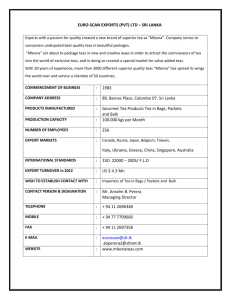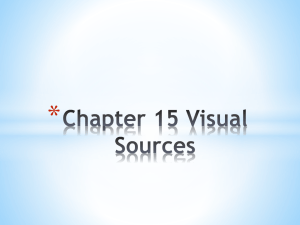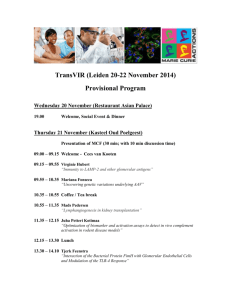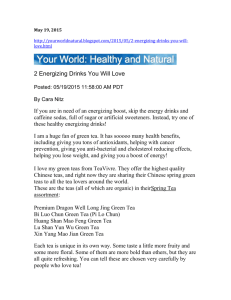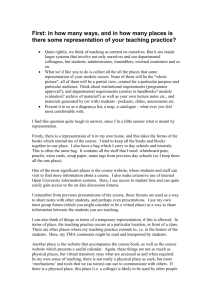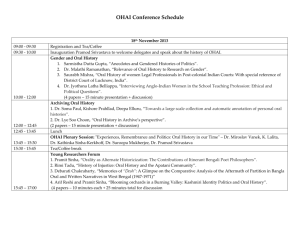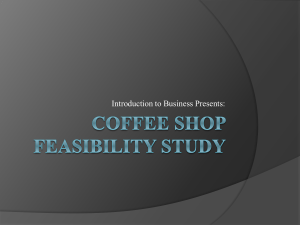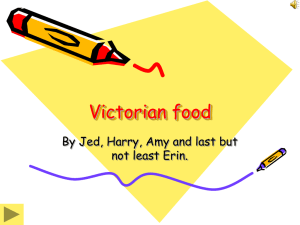titles - webALUMNUS
advertisement
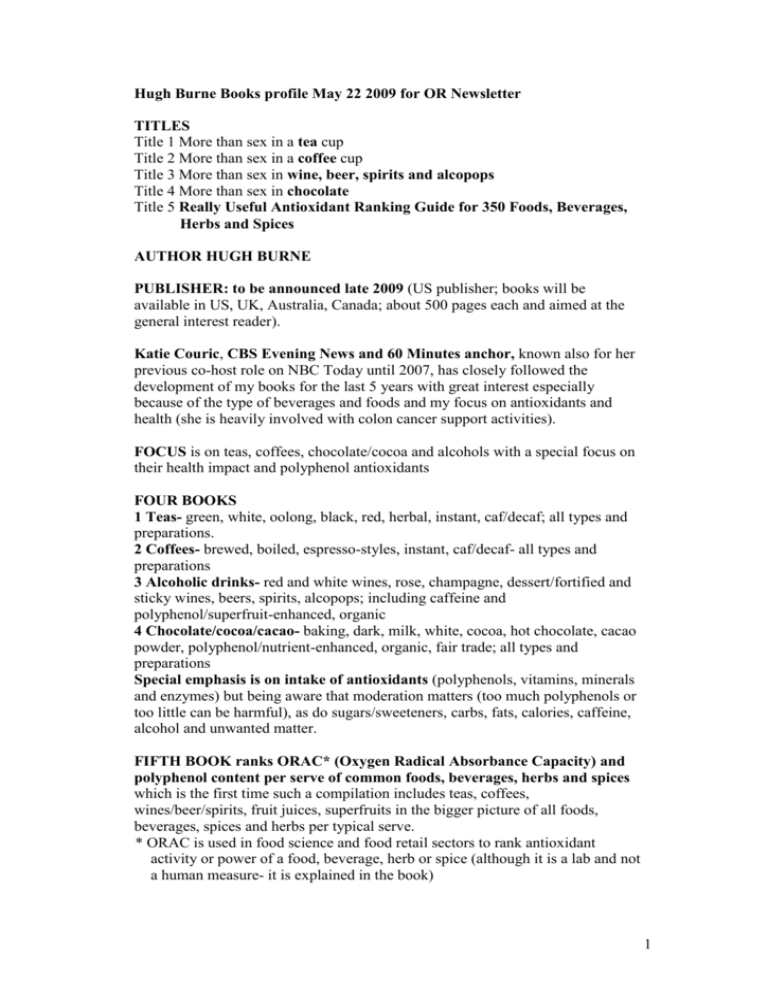
Hugh Burne Books profile May 22 2009 for OR Newsletter TITLES Title 1 More than sex in a tea cup Title 2 More than sex in a coffee cup Title 3 More than sex in wine, beer, spirits and alcopops Title 4 More than sex in chocolate Title 5 Really Useful Antioxidant Ranking Guide for 350 Foods, Beverages, Herbs and Spices AUTHOR HUGH BURNE PUBLISHER: to be announced late 2009 (US publisher; books will be available in US, UK, Australia, Canada; about 500 pages each and aimed at the general interest reader). Katie Couric, CBS Evening News and 60 Minutes anchor, known also for her previous co-host role on NBC Today until 2007, has closely followed the development of my books for the last 5 years with great interest especially because of the type of beverages and foods and my focus on antioxidants and health (she is heavily involved with colon cancer support activities). FOCUS is on teas, coffees, chocolate/cocoa and alcohols with a special focus on their health impact and polyphenol antioxidants FOUR BOOKS 1 Teas- green, white, oolong, black, red, herbal, instant, caf/decaf; all types and preparations. 2 Coffees- brewed, boiled, espresso-styles, instant, caf/decaf- all types and preparations 3 Alcoholic drinks- red and white wines, rose, champagne, dessert/fortified and sticky wines, beers, spirits, alcopops; including caffeine and polyphenol/superfruit-enhanced, organic 4 Chocolate/cocoa/cacao- baking, dark, milk, white, cocoa, hot chocolate, cacao powder, polyphenol/nutrient-enhanced, organic, fair trade; all types and preparations Special emphasis is on intake of antioxidants (polyphenols, vitamins, minerals and enzymes) but being aware that moderation matters (too much polyphenols or too little can be harmful), as do sugars/sweeteners, carbs, fats, calories, caffeine, alcohol and unwanted matter. FIFTH BOOK ranks ORAC* (Oxygen Radical Absorbance Capacity) and polyphenol content per serve of common foods, beverages, herbs and spices which is the first time such a compilation includes teas, coffees, wines/beer/spirits, fruit juices, superfruits in the bigger picture of all foods, beverages, spices and herbs per typical serve. * ORAC is used in food science and food retail sectors to rank antioxidant activity or power of a food, beverage, herb or spice (although it is a lab and not a human measure- it is explained in the book) 1 CONTENTS OF BOOKS 1-4 - health pluses and minuses- which types, how much and for whom are they healthy or harmful? This allows the smart, healthy-lifestyle-conscious general interest reader or people with specific health conditions to look up, referencestyle, a simplified, orderly, indexed, evidence-based, source-referenced health pluses and minuses from consumption of typical servings of these beverages and chocolate, from the tightly focused (example: green tea’s possible protective effects specifically for breast cancer) to the less focused (example: green tea and a list of all possible health- protective effects of green tea based on the evidence). - polyphenol, nutrient and other content per serve compared to suggested daily dietary intake; includes polyphenol antioxidants for the first time and some astounding revelations especially for caffeine content of different types and preparations of coffee, polyphenols, resveratrol, tannins, calories, various types of fats (including unnatural and natural transfats- did you know this difference and which foods they are in, and that while unnatural is harmful, natural may not be), sugars and carbs, protein, fibres, vitamins and minerals, alcohol (ethanol), oxalic acid, salicylates, sulfites, histamines, tyramines, tyrosol, acrylamides and much more. - extra calories, fats, carbs per serve guide from additions such as milk, soymilk, creams, creamers/whiteners, ice cream, sweeteners, sugar and honey, lemon - issues with water source (including comparison of water filters) used for beverage preparations - comparisons of each product with the others (tea with coffee and so on) - effects on women showing differences from effects on men (differences for alcohol are well-known in general but many specific alcohol effects may be surprises [to many women too!], and many specific surprises are addressed for teas, coffees and chocolate/cocoa; also pregnancy and lactating and pre and post-menopausal included) - impact on special groups such as pregnant and lactating women, older people, post-menopausal women, specific gene-types, children and teens. - list of myths with evidence-based explanations and there are many surprises - organic vs conventional (organic has more nutrition? Think again! Organic has less unwanted matter? Not guaranteed but likely!) - natural food vs supplements is reviewed from evidence-based facts (for the general interest consumer, reports in media and from vested interest groups on health-impact from supplements are highly confusing, misunderstood and misrepresented. Are we wasting our money? Are we harming rather than benefiting our health?) - a very useful caffeine content comparison list because, unlike other published caffeine guides, it includes real-life variations of types and preparations of teas, coffees and chocolate/cocoa and also caffeine-enhanced alcoholic and “energy” beverages; plus a summary of all the pros and cons of caffeine on our health with source references including latest research studies to this date - nutrition and health information on labels- how useful really? - what are antioxidants and polyphenols? You will likely have heard their names (like EGCg as in green tea or resveratrol as in red wine), and you can see where and what they are without reading a book on biochemistry. 2 - - Sexy bonus section in each book: effect on your sex life, libido, stress and orgasm from consuming tea, coffee, caffeine, chocolate, alcoholic beverages and other foods, herbs and spices. Having a problem? Read this section. There is some factual fun reading too. Check this out: tea and sex is a double dose of stress relief (it helps if you do it before a public presentation at work, but you will need more tea than sex). I have tried this (I mean the section) on several people and it’s a magnet (especially for women; men I think are more shy on these topics. all statements and studies cited in my books are supported by source references. CONTENTS of BOOK 5 - alphabetical index by food/beverage category for the main polyphenol and ORAC ranking guide - quick-glance snapshot ORAC ranking per typical serve by name of food/beverage - quick-glance snapshot polyphenol content ranking per typical serve by name of food/beverage - two main ranking comparison guides side by side in numerical ranking order showing a) ORAC b) total polyphenol content measurements per typical serve with source references and explanations for the different types and preparations of foods/beverages - plus special subsections at the end of the guides: - effects of food processing, preparation and storage on ORAC and polyphenol content - PLU codes for conventional, organic and GM (that little stick-on label on fresh fruit and veg) - organic vs conventional-which is better; from the evidence-based facts? - GM foods - nano technology in our foods - functional foods - fruit juices- do you know what you are buying; how nutritious they are and how deceptive is the labeling? - glossary of terms- antioxidants (polyphenols, vitamins, minerals, enzymes) in the appendix TEA- what are your health stakes? Tea drinking is a refined culture in healthy living, relaxation and hospitality. There’s more to that relaxing cuppa than you think. For most healthy, nonpregnant adults polyphenols and other constituents in traditional camellia sinensis tea may be selectively protecting your health better than most other beverages and foods. But there is evidence of a saturation intake of 6-7 cups (not many know this) of green or black tea a day (less for white tea) above which you get no more benefit and in fact it may become harmful. Moderation is key for all foods and beverages. And, what about red teas, herbal teas, coffees, chocolate and cocoa, wines, beers and spirits? You have to read the books ! 3 On balance for most adults, traditional tea (green, white, oolong and black camellia sinensis teas) is our winner in the health stakes when comparing traditional teas, red teas, herbal teas, coffee, chocolate and cocoa and alcoholic beverages such as wines, beer and spirits. ALCOHOL. The contents of my book on wines/beer/spirits/alcopops are a draw card especially the myth busters, the health pluses and minuses and the special focus on the impact on teens, women (compared to men) and pregnancy. There is a huge release of bottled-up interest in alcohol (pardon the pun). Most have thought about it, few bring it up (unintended ambiguity), and they (and I) say there is nothing useful published other than for (legitimately) trashing binge drinkers (and most don’t regard themselves as binge drinkers). Whereas it is common for wine and beer drinkers to binge and they know the effects of trashing themselves (2/3 of alcohol drinkers are irresponsible drinkers and should know more), a huge 1/3 are regarded as responsible drinkers and they want to know more. Surprisingly, moderate wine and beer drinkers know little about health effects other than a vague reference to heart benefits and adverse alcohol toxicity but I found many moderate drinkers worry whether they are drinking to excess, don’t have answers and would like to know. Alcohol abuse bodies and medical professions are reluctant to focus on health benefits of alcoholic drinks for fear of misuse of information (there is a degree of validity as an estimated 2/3 of alcohol drinkers are in the risky or high risk categories). On the other hand, the alcohol industries are seen to overplay and oversimplify benefits in alcoholic drinks as publicized from research studies. However there is an enormous 1/3 or more who are responsible alcohol drinkers but substantially deficient in their understanding of the health pluses and minuses of alcohol consumption. Example surprises (to most people) in my book a) Why it is better to abstain from alcohol during pregnancy; check out the number of foetus brain cells permanently destroyed after a moderate consumption of alcohol; this was a mouse study because you cannot do this kind of test on a human foetus but, in any case, are you prepared to take this risk? Did you know 2 glasses of wine or the equivalent alcohol content in beer and other spirits consumed over 45 minutes irreversibly kills 20 million brain neurons* in third trimester foetus of pregnant mice (pregnant women I have spoken to have been stunned; 61% of women in UK drink alcohol during pregnancy); there are a lot more revelations in this guide. * true, it is a small percentage of the 100 billion neurons in the human brain but we do not know the significance of its impact b) Did you know consumption of alcohol an hour or two before meals but not with meals may help manage weight (this is explained in my book). c) the typical wine glass (1/2-3/4 filled) is at least* 2 times the standard alcohol unit used by country Alcohol Guidance bodies. There’s a lot more on this in my book. That in my view has established a huge educational problem for getting the message across about binge drinking, misuse of alcohol and the toxic effect on the human body. We have brought up our kids in a culture of acceptable alcohol drinking being the norm. * some red wine glasses are 10 times!! 4 COFFEE I have found coffee drinkers openly concerned about health effects. Most I have spoken to had no idea coffee contains much more antioxidants than teas (but substantially less potent and narrower effects than tea as explained in my book). Did you know that decaf coffee’s health pluses and minuses are both worse for most people compared to caf coffee (and that is before any possible detrimental effect from the decaf process!). They don’t know that decaf coffee can increase the so-called bad cholesterol (that is not helpful), has less antioxidants than caf coffee (that is not helpful) and significantly increases the good HDL2 cholesterol (that is helpful, but only for obese people). The surprise: the good HDL2 significantly decreased in all non-obese people drinking decaf coffee. They seem surprised that 50% of the US population may have the slow caffeine metabolism gene variant and two or more cups coffee a day can increase risk of heart attack by 5-10% compared to those who don’t have the slow caffeine gene (all people carry 2 copies of this particular gene, but 50% of the US population have the slow variant for one or both, some have the fast variant and some have no variants and you can be tested for it). CHOCOLATE Women in a broad age-group (teens to elderly) crave for chocolate more than men. Chocolate is the number one food craving for women, especially just prior to menstruation. Chocolate consumption is associated with temporary “feel good” moods and its neurochemicals and minerals are suspected to be the active ingredients but there is debate (this is explained in my book on chocolate). Men crave for spicy foods but chocolate still ranks in their top 5 cravings which put men firmly on the potential readers list. From nutritional habit surveys it is rare for chocolate cravers to over-indulge (it’s in my book on chocolate/cocoa), but I found most chocolate lovers simply don’t know where they stand and they would like to know. Chocolate is the most popular endorphin-producing food in the world but did you know it takes a hot marathon 2 hours of non-stop moderately vigorous sexual encounter (or a 12 mile/ 19km walk) to burn off a single 100g (3.5 oz) chocolate bar. Did you know that caffeine in coffee can be detrimental to libido, but the reverse is true for caffeine in tea. It’s explained in my books. THESE BEVERAGES AND FOODS IMPACT WOMEN DIFFERENTLY FROM MEN This is extensively collated and highlighted in my books and there are many surprises, notwithstanding that most people know there are differences from alcohol consumption. PREGNANCY I place pregnancy prominently in my books. This is a major topic of concern judging from emails I have received in my tea business from US consumers. Women are having children later (although the trend is reverting to earlier ages) and these older women are much savvier about diet, health, ageing and looking good. The “older” body has much more difficulty recovering from childbirth. 5 This should broaden the market attraction. Children are included in my caffeine topics especially (again a topic of many emails to me from US consumers). SEX IS IMPORTANT TO MOST PEOPLE My books have a great section on sex, stress, libido and orgasm and from the few trials with people, it works its usual magic. It’s a magnet 100% of the time and with very favourable feedback. This is different from other publications. It focuses mostly on the effects from consuming tea, coffee, chocolate, alcohol and caffeine but I have added other foods, herbs and spices for completeness. A survey of women in the UK has revealed that over a half (52%)* of them would prefer chocolate to sex for guaranteed pleasure (yes, Cadbury commissioned the survey but it seems consistent with the known sexual satisfaction mismatch between men and women as partners, and the widespread lack of sexual confidence in men and women; it may well represent the true state of men-women sexual relationships). About 2/3 (66%) of these women regarded chocolate as a mood enhancer, exceeding the 57% of men with that view and just 38% of men were aware that chocolate released endorphins (women’s opportunity to boost unsuspecting men). Twice the 18-24 year olds (men and women) were aware of endorphin boost from chocolate compared to the over 55’s (survey of 1524 UK adults commissioned by Cadbury, reported June 6, 2007). * a survey in Australia found 15% of women (in 18-34 years age group) preferred chocolate to sex (42% or nearly or nearly half of these young women regarded themselves as overweight or obese; Cosmopolitan magazine survey, reported Sept 2007). THESE BOOKS ARE ABOUT YOU AS AN INDIVIDUAL. “ONE SIZE FITS ALL” RARELY FITS ANYONE. Reality is that when these popular beverages and foods get into our bodies the mix and its effect on our health gets extremely complex. Besides the complex interactions of chemistry and biochemistry, it compounds because everyone is different including their health condition, genetics, lifestyle, diet, gender, age and metabolism and there is no simple “one size fits all”. Individually, consumers are acutely aware of this. However, popular press continues to embrace a “one size fits all” mentality and feeds consumers with the latest headline (past headlines are off the radar) and “easy to follow” suggestions because popular press is living in the past believing in the gullible consumer still wanting to hear simple things which ignores the substantial and growing development of savvy consumers (huge growth in the use of the web alone testifies to this). Consumers today are looking for healthy longevity and are prepared to digest material in more depth to fit the circumstance to themselves personally. They want to understand whether health and nutrition claims associated with these popular beverages and foods are fact or fiction or whether their consumption will help or hinder their health, longevity or pregnancy. There is huge personal stake and satisfaction in healthy attractive functioning and ageing for both genders and the impact from consumption of these most popular beverages and foods is highly influential. Just about everyone consumes teas and /or coffee; a high percentage consumes alcohol (I have seen estimates of about a half of the adult population in the US) 6 and chocolate is especially popular with women. That covers most adults (male and female) and a big chunk of teens. RANDOM EXAMPLES OF TOPICS IN MY BOOKS a) coffee and caffeine are not synonymous despite popular opinion to the contrary. b) caffeine in tea has different health effects compared to caffeine in coffee. c) I was surprised how few people knew there were natural and unnatural transfats and that the health impact seems to be very different, or knew much if anything about acrylamides (both these constituents can turn up in beverages and foods) d) the health controversy with soy is dealt with in my books because some people add soymilk to teas for example. e) organic versus conventional is a most misunderstood topic among consumers. On average from the evidence you are likely better off with organic because it is likely but not guaranteed to contain less unwanted matter such as pesticides and herbicides. However, organic does not necessarily contain more nutrition (in fact it is a mixed bag; sometimes more, sometimes less) for a variety of reasons explained in my books and some of these reasons will surprise many consumers (evidence is likely to remain far from watertight; but what else in life is; if you take the chance that organic is better, you are more likely than not to make the correct choice). f) red teas are a “low polyphenol antioxidant content” surprise especially when compared to regular (camellia sinensis) teas which we know as black, green, white and oolong teas. Red teas are not camellia sinensis teas. g) did you know that if antioxidants are high in a tea, caffeine is also high (excluding decaf of course); they go hand-in-hand; so next time someone tells you white tea has little caffeine per serving (its on some prominent websites) you have an answer- it is highest of all teas. h) How does presence of milk affect health attributes of antioxidants in tea, coffee and chocolate/cocoa? This is important because most tea drinkers in western countries add milk (lesser practice in US and some parts of Europe); also milk chocolate is more popular than dark and many coffee drinkers add milk or cream (unusual to add cream to tea). This question has been put to me by an extraordinary number of consumers. It depends on your health risks and what you want to protect against. If you have skin cancer risk then you can drink tea with full cream milk and it does not affect skin cancer protection very much (much reduced skin cancer protection from DECAF tea, only caf tea gives this protection; we do not know yet much about the effect of adding milk on other cancer protections- a little milk (2 teaspoons) in black tea boosts protection against breast* and colon cancers yet a larger amount neutralizes the effect; little milk OK, not more) . If you are at risk for heart disease then you should drink tea without milk as substantial protective benefits (but not all as you may still have protection from LDL oxidation**) are lost with milk. If you need insulin boost then you should drink tea without milk or with l5ml 2% 7 fat milk (but you will lose some benefit and lose almost all if you add more); if you want to inactivate anthrax bacterium then you should drink black tea with no whole milk (low fat milk not studied) as the effect was totally lost. Use low fat milk if you have to add milk to tea (except for the skin cancer protection where you can use full cream or low fat milk). If you want the full protective effects of tea then you should drink tea without milk. * unlike green tea, black tea’s (without milk) protection against breast cancer is unclear from studies ** holds true for black tea with 10% milk (other teas not studied but same effect expected), coffee with 10% milk and cocoa with 66% or 2/3 milk COMMON MYTHS ARE (none of the following is true as a general statementthe evidence-based refutations are in the book): green tea has more antioxidant power and health benefits than black tea: white tea has less caffeine than green tea; green tea has less caffeine than black tea; an effective quantity of powerful antiageing antioxidant resveratrol is present especially in red wines; all wines are rich in antioxidants; organic wines have lower sulfite content than conventional wines, cannot manage weight with consumption of alcoholic drinks, high doses of antioxidants, vitamins and minerals supplements give commensurately increased health protection; herbal teas contain no antioxidants; tea has more antioxidants than coffee; red teas have more powerful antioxidants than green tea and are a useful source of vitamins and minerals; tea has high content of methyl salicylate (on many prominent US allergy web sites); teas are high in oxalates (kidney stones issue); teas reduce body iron absorption from all sources; chocolate’s saturated fats are bad for the heart; caffeine in serving of chocolate is as much as tea or even coffee, oregano is at the top of the ORAC ladder. And there is much more. 8
